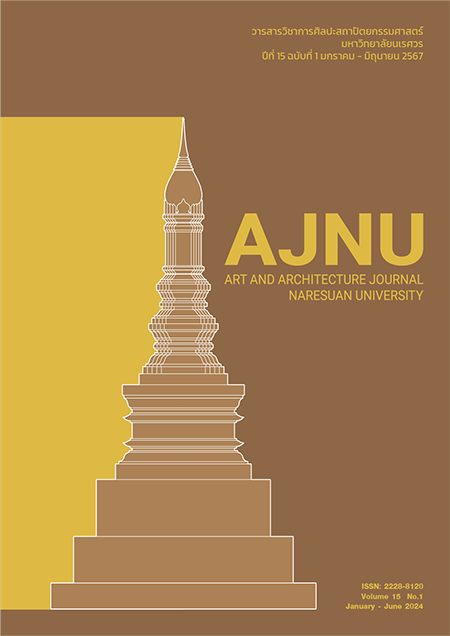The development of product prototype for Thai hanging from the loincloth
Main Article Content
Abstract
Research on The development of product prototype for Thai hanging machine from the loincloth Purpose for 1. Design and develop products prototype for Thai hanging machine from the loincloth. 2.Transfer development knowledge develop products prototype for Thai Hanging Machine from the Loincloth and 3. Study consumer satisfaction with products Thai Hanging Machine from the Loincloth. There are steps for conducting research as follows: 1. Study basic information about the styles of Thai hanging machines. 2. Analyze data for use in design. 3. Select a draft of Thai hanging machines product from loincloth according to the design concept. 4.The Development of Product Prototype for Thai Hanging Machine from the Loincloth Purpose. 5. Transferring knowledge on The Development of Product Prototype for Thai Hanging Machine from the Loincloth for students of Boriboonsin Rangsit School Pathum Thani Province. 6. Evaluate customer satisfaction with the prototype of a loincloth hanging product by selecting 50 consumers by purposive sample from 1st-4th year students in the Creative Technology Department. Assess the satisfaction of transferring information about creating prototypes of hanging items from loincloths to teachers and students at Boriboonsin Rangsit School in Pathum Thani Province, conducted by the Faculty of Home Economics Technology at Rajamangala University of Technology Thanyaburi. By purposive sampling, 30 individuals were randomly selected. The research results revealed that the experts had chosen a style of puangkeaw hanging. The hanging gadget is of medium size and features pentagonal geometric shapes. It combines traditional Thai art with modern techniques using a unique synthetic material made from loincloth and various sorts of crystals. Flower-shaped prototypes of hangings were made using loincloths coated with gelatin. The study on consumer satisfaction with loincloth-based hanging products revealed that respondents were pleased with the innovative use of materials in generating new and imaginative sizes, forms, and qualities. Are highly content the mean values were 4.84, 4.72, and 4.82, in that order. The loincloth hangers were highly content. The mean value was 3.76. The satisfaction about the color and beauty of the work items was moderate. The mean value was 3.04.Transferring information on making prototypes of hanging products from loincloths to teachers yielded results. Students at Boriboonsin Rangsit School in Pathum Thani Province discovered that the majority of respondents were content with the teachers' knowledge transfer. The content in knowledge transfer is at its peak level, reaching 83.33%. The percentage reached its peak at 76.66 percent. Respondents expressed high satisfaction with the training process, including the equipment and materials preparedness, training period appropriateness, and overall service, which was rated at 100.00 percent. The trainees were really delighted with the usage of information. Capable of utilizing acquired knowledge to innovate and implement it effectively in professional settings. 80.00% can utilize the acquired knowledge in their everyday lives. 76.66% can disseminate the information. Can transfer 63.33% and apply received information with 56.66% certainty.
Article Details

This work is licensed under a Creative Commons Attribution-NonCommercial-NoDerivatives 4.0 International License.
References
กิตติศักดิ์ ธรรมศักดิ์ชัย และคณะ. (2558). การศึกษาและพัฒนาของที่ระลึกจากเครื่องแขวนไทย. วารสารวิชาการ
ศิลปะสถาปัตยกรรมศาสตร์ มหาวิทยาลัยนเรศวร, 6(1),149-160
แกล้วทนง สอนสังข์. (2546). การศึกษางานศิลปะหัตถกรรมกระจูดใน จ.นราธิวาส พัทลุง และสุราษฎร์ธานี (กศ.ม.)
กรุงเทพฯ: บัณฑิตวิทยาลัย มหาวิทยาลัยศรีนครินทรวิโรฒ.
ชอบ เข็มกลัด และโกวิทย์ พวงงาม. (2547). การวิจัยเชิงปฏิบัติการณ์อย่างมีส่วนร่วมเชิงประยุกต์. กรุงเทพฯ: สำนักพิมพ์เสมา
ธรรม.
ทะนุพงศ์ กุสุมา ณ อยุธยา. (วันที่ 21 กุมภาพันธ์ 2556). ศิลปหัตถกรรม.. หนังสือพิมพ์มติชนคอลัมน์เส้นทางเศรษฐี
อาชีพอิสระของคนทำกิน. สืบค้นเมื่อ 8 มีนาคม 2558, จาก
https://www.sentangsedtee.com/news_detail.php?rich_id=280§ion=2
นวลน้อย บุญวงษ์. (2542). หลักการออกแบบ. พิมพ์ครั้งที่ 2.กรุงเทพฯ: จุฬาลงกรณ์มหาวิทยาลัย.
พวงผกา คุโรวาท. (2535). คู่มือประวัติเครื่องแต่งกาย. รวมสาส์น. กรุงเทพฯ. สืบค้นเมื่อ 28 กุมภาพันธ์ 2558, จาก
มณีรัตน์ จันทนะผะลิน. (2542). เครื่องแขวนไทย ดอกไม้สด. หนังสือชุดมรดกไทย เล่มที่4. สาขาศิลปะประดิษฐ์
ภาควิชาคหกรรมศาสตร์ คณะวิทยาศาสตร์ วิทยาลัยครูสวนดุสิต. กรุงเทพฯ.
สุรเชษฐ์ ไชยอุปละ. (2546). การศึกษาและพัฒนารูปแบบผลิตภัณฑ์เครื่องจักสานผักตบชวาสำหรับศูนย์ศิลปาชีพบางไทร.
(คอ.ม.). กรุงเทพฯ: บัณฑิตวิทยาลัย สถาบันเทคโนโลยีพระจอมเกล้าเจ้าคุณทหารลาดกระบัง.
อภิรัติ โสฬศ และคณะ. (2559). การพัฒนามาลัยจากผ้าด้วยเทคโนโลยีการตกแต่งกลิ่น. คณะเทคโนโลยีคหกรรมศาสตร์
มหาวิทยาลัยเทคโนโลยีราชมงคลพระนคร.
Nichanan Angi. (2023). วิวัฒนาการ, ความสำคัญ และการออกแบบชองเครื่องแขวน: การทดลองศึกษาลึกซึ้งใน
ประวัติศาสตร์ศิลป์ไทย. ร้านขายของตกแต่งบ้านออนไลน์และกิ๊ฟช็อปในกรุงเทพฯ. สืบค้นเมื่อ 12 มกราคม 2567, จาก
https://www.macramebynicha.com/blogs/infos/เครื่องแขวนไทยคืออะไร


